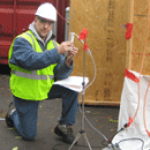Reliable Asbestos Air Testing Approaches
Your Guide to Effective Asbestos Checking Treatments
Asbestos testing treatments are an important part of ensuring the safety and security of interior settings, specifically in older buildings where this hazardous material may exist. The possible health and wellness risks related to asbestos direct exposure make it critical to approach testing with precision and thoroughness. From comprehending the buildings of asbestos to effectively analyzing test results, a thorough guide can gear up people with the expertise and tools required to browse this complex process. Stay tuned to reveal the vital actions and factors to consider that can help you guard versus the risks presented by asbestos.
Understanding Asbestos and Its Threats
Asbestos, a naturally happening mineral understood for its heat resistance and longevity, positions extreme health and wellness threats when its fibers are inhaled or ingested. asbestos survey near me. Direct exposure to asbestos can bring about serious health problems such as lung mesothelioma, cancer cells, and asbestosis. Regardless of its beneficial buildings, asbestos has actually been commonly outlawed in numerous nations because of the tested web link in between asbestos direct exposure and these life-threatening illness
When asbestos-containing products are disrupted or harmed,The danger exists in the tiny fibers that can quickly come to be airborne. When inhaled, these fibers can come to be lodged in the lungs, creating swelling and scarring gradually. The latency period in between exposure to asbestos and the development of relevant conditions can cover a number of years, making early detection and prevention vital.
Asbestos was typically used in building materials, insulation, and automobile parts prior to its health and wellness risks were totally understood. Today, proper screening and elimination of asbestos-containing materials are important to shield people from the threats connected with asbestos exposure.
Identifying Potential Asbestos Materials
The identification of potential asbestos materials is a vital step in making certain the security of people exposed to hazardous substances in different atmospheres. Asbestos can be found in a wide variety of structure materials, including but not restricted to insulation, ceiling ceramic tiles, flooring tiles, concrete sheets, and roof covering shingles - Asbestos Air Sampling. Determining these materials properly is necessary to successfully managing the dangers related to asbestos exposure

In situations where aesthetic inspection is inconclusive, samples of believed products can be accumulated and sent out to recognized labs for testing. These labs utilize specialized strategies such as polarized light microscopy or transmission electron microscopy to precisely determine the visibility of asbestos fibers in the samples. By complying with strenuous recognition procedures, people can effectively minimize the risks linked with asbestos exposure.
Choosing the Right Testing Approach
Identification of potential asbestos materials plays a crucial function in determining the suitable screening technique for exact asbestos fiber discovery. Once presumed materials have actually been recognized, selecting the best screening technique is necessary to make sure trusted results. There are two main approaches for asbestos screening: polarized light microscopy (PLM) and transmission electron microscopy (TEM) PLM is commonly used for initial screening as it is affordable and gives quick outcomes. Nonetheless, PLM has constraints in discovering asbestos fibers that are smaller than 1 to 3 microns. On the various other hand, TEM is an advanced technique that can precisely identify asbestos fibers at the ultrastructural level. While TEM is a lot more expensive and taxing than PLM, it provides higher sensitivity and specificity in asbestos discovery. Picking the ideal screening approach depends upon numerous factors such as the type of product being examined, the called for level of sensitivity of the evaluation, and the offered budget plan. It is essential to seek advice from approved asbestos screening professionals to identify the most ideal approach for your particular testing needs.
Carrying Out Sample Collection Securely
When accumulating examples for asbestos testing, focusing on safety measures is paramount to lessen potential direct exposure dangers. Asbestos fibers are harmful when disturbed, making it essential to follow proper safety methods during example collection - asbestos air testing. Before starting the sampling procedure, guarantee that you are outfitted with individual protective tools (PPE) such as non asbestos pipe insulation removal cost reusable coveralls, masks, safety glasses, and gloves to avoid breathing or contact with asbestos fibers
It is important to wet the sampling area making use of a gentle mist of water to stop the fibers from coming to be air-borne during collection. When gathering examples and stay clear of hostile scraping or drilling that might release asbestos fibers into the air, Use care. Rather, carefully cut a small item of the material using suitable tools and position it into a sealed container for analysis by a licensed lab.
Moreover, classifying each example with detailed information concerning the sampling collection agency, day, and place's name is important for accurate record-keeping and evaluation. By complying with these security guidelines, you can carry out sample collection for asbestos screening efficiently while lessening the danger of exposure.
Interpreting Examination Outcomes and Following Steps

Conclusion
Finally, effective asbestos screening procedures are essential in determining and managing prospective health dangers related to asbestos exposure. By recognizing the dangers of asbestos, determining possible products, picking the ideal screening method, carrying out example collection safely, and translating examination results accurately, individuals and companies can take the required steps to shield themselves and others from the hazardous impacts of asbestos. It is critical to prioritize safety and appropriate screening methods to ensure a healthy atmosphere for all.

Recognition of prospective asbestos materials plays an essential function in identifying the suitable screening approach for precise asbestos fiber detection. The examination results will show the visibility or absence of asbestos, the type of asbestos fibers existing, and the concentration levels.In conclusion, reliable asbestos testing procedures are important in identifying and taking care Full Report of prospective health threats connected with asbestos exposure. By understanding the threats of asbestos, determining potential read review products, selecting the right screening method, performing sample collection securely, and translating examination results properly, people and organizations can take the needed steps to secure themselves and others from the hazardous results of asbestos.